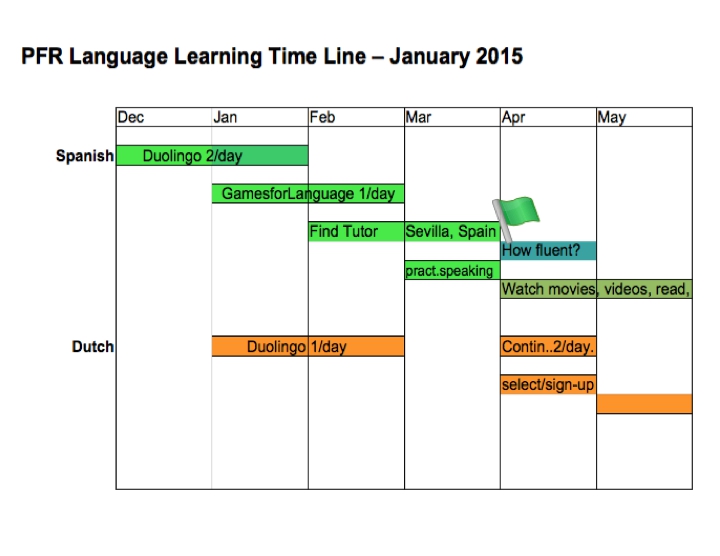2 Strategies for Relearning a Dormant Language
 Is relearning a language a language hard? Not if you have the right mindset.
Is relearning a language a language hard? Not if you have the right mindset.
A couple of weeks ago, when buying a laptop in one of those trendy stores, we had a typical conversation with a young saleswoman. “Oh, you guys speak German,” she beamed, as she came back from helping another customer. “I thought I recognized the language, all those scratchy sounds.”
She continued: “Well, I took Spanish in school and college. I used to speak it pretty well. But, it's been a couple of years since then. I'd really like to relearn it." She added sheepishly, "Now I couldn't say anything in Spanish if my life depended on it."
That wasn't true, of course. My husband immediately tried his Spanish on her, and she responded with a couple of simple phrases. “Okay” she said, “but I would need to go to Mexico and live there for a while. I bet Spanish would come back.”
At the moment, it looked like she was busy getting her work life together. She didn't really seem focused on language learning. But she got us thinking again about how adults can get back a foreign language they once knew.
Relearning a language has to be one of the smartest decisions you can make. There are so many benefits involved. Besides adding a notable skill to your resume, you're giving your brain a fantastic workout.
Also, knowing another language makes traveling much more fun. For more benefits, read lingholic's blog post. Simply said, if you're open to the pleasure of language learning, it's always worth it.
1. Reactivating a classroom language
When you learn a language in school or college and then stop using it, you may feel after a while that it's “gone.”
But is that really so? As studies have shown (using functional magnetic resonance imaging, fMRI, as described in this academic Sciencedirect.com article): When you learn a new language, your brain undergoes neural changes, which have short and long-term effects on language learning and cognitive control.
This Guardian article explains what happens to the brain when you learn a language in a less scholarly way.
From such studies, it becomes apparent that a second language - even when learned as an adult - retains a presence in your brain. This neurological presence gives you a head start on various aspects of the language, ones that a newcomer would have to learn from scratch. Traditionally, classroom learning has tended to be somewhat heavy on textbook exercises and reading, and (necessarily) a little light on speaking practice. Classroom learners acquire reading and writing skills, and at least a basic understanding of grammar.
Traditionally, classroom learning has tended to be somewhat heavy on textbook exercises and reading, and (necessarily) a little light on speaking practice. Classroom learners acquire reading and writing skills, and at least a basic understanding of grammar.
Therefore, reading will likely be the most effective way to reactivate a classroom language that you've put aside. Plus, if you liked the writing exercises, you can easily bring this skill to life again by first copying texts and later participating in a language community on one of the social networks.
Some have found that labeling objects in their home with Post-its will boost their vocabulary. A further step would be to try one of the interactive online language programs. In some ways, they are a perfect tool for adults who want to reactivate a language.
Many of the online programs or apps have you learn or review a language in various ways: identify a word you hear, write the translation, repeat after a native speaker, figure out grammar patterns, put together basic sentences, etc. In this way, you can practice - and relearn - the sounds, spelling, essential grammar, word order, and vocabulary of the language you want to brush up.
All of the above-mentioned ways give you an easy start, and can definitely get you going. To this you'll want to add more reading, and a lot of listening, and as much speaking as possible.
Speaking is probably the hardest skill to acquire for former classroom learners. Fortunately, there are a lot of options for practicing speaking (even if you don't have family members or friends who speak the language you're relearning). If you're the social type, you'll find plenty of free opportunities with language exchange partners, language communities on Facebook, etc.
Paid options include Skype lessons, online tutors such as italki, or courses such as Pimsleur audio programs. For the latter, I would suggest starting with Level 2 or 3, because you're not a beginner.
2. Relearning a childhood language
If you spoke a language as a young child, and then forgot it because it was gone from your life, you may take a different path for relearning the language.
My own experience is informative here: My first language was German. When I was 9 and 10, I went to school in the Netherlands.
Then, after moving to Canada, I had to learn English and had little exposure to Dutch and German. It was only after the family had settled in and my siblings and I did well in school, that my family started using German and Dutch again at home. It was mostly just by speaking that I kept these languages alive.
Young children learn a language by hearing and speaking it, often during play.  At the same time they are learning to make sense of the world around them. They discover objects and actions, become aware of emotions, and find out how to communicate their needs and wants.
At the same time they are learning to make sense of the world around them. They discover objects and actions, become aware of emotions, and find out how to communicate their needs and wants.
The sounds of the words, which they hear and learn to say themselves, become deeply imprinted on their brain. For young children, the spoken word is paramount because it functions as a tool for discovery and survival.
So, it's especially language as sound, which imprints itself on a young child's brain and leaves a "permanent" mark, as this Guardian article explains. Thus, for adults who spoke another language as a child, reactivating native pronunciation and sentence intonation will come pretty easily. Listening to songs and stories has proven to be a good first step to relearning a “lost” childhood language.
Even more effective would be having conversations with a friend or family member. If he or she can gently correct your mistakes, all the better.
Then, there are other skills to learn. You may have to learn a new spelling and writing system from scratch, as well as essential grammar rules, if you had no formal instruction before. Though a child may have acquired a good-sized vocabulary, the adult has to learn grown-up, formal, and specialized language.
If you're interested in new discoveries about bilingualism and language acquisition, look at François Grosjean's book Bilingual: Life and Reality or check out his Psychology Today blog “Life as a Bilingual: The reality of living with two (or more) languages.”
Make a Plan and Build a Habit
 Once you've made up your mind to get a (somewhat) forgotten language back into your life, it helps to make a project out of it. Be clear in your mind why you want to relearn the language.
Once you've made up your mind to get a (somewhat) forgotten language back into your life, it helps to make a project out of it. Be clear in your mind why you want to relearn the language.
Then set some goals and decide on a daily schedule that you can easily stick to. One way to start is to Build a Habit with the 20 minute Rule. The “20 minute Rule” is based on the idea that you can do anything for twenty minutes, even if you find the activity hard to get into.
So, don't think too much about it. Nike's right: “Just Do It.”
Bio: Ulrike Rettig is the co-founder of GamesforLanguage.com. She's a lifelong language learner, growing up in Austria, the Netherlands, and Canada. You can follow her on Facebook, Twitter and Instagram, and leave any comments right here!
